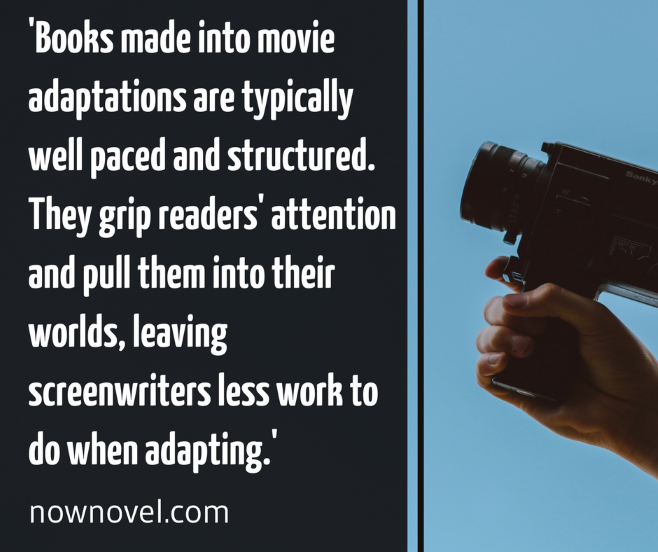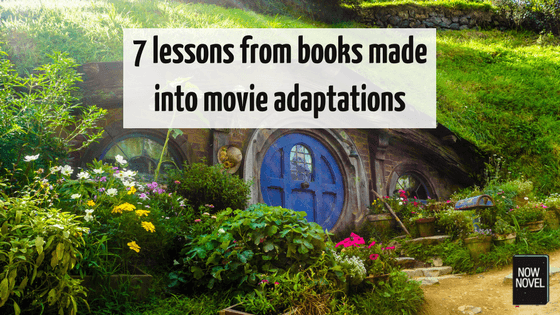Many authors who have had books made into movie adaptations have become multi-millionaires almost overnight. Why are some books primed for screen adaptation from the start? They share in common strong high concepts, great structure, visual flair and more. Read 7 lessons from books adapted for screen that will help you make your novel blockbuster material:
1. Brainstorm a strong central idea or high concept
2. Work at your story’s structure for good plot
3. Make your fictional world visual and vivid
4. Tap into universal story themes
5. Make your prose lean and effective
6. Write dialogue that gets books made into movies
7. Think for the silver screen: Show more than tell
Let’s explore each of these tips with examples from books adapted for film:
1. Brainstorm a strong central idea or high concept
Movie-ready books have good central ideas and high concepts. A ‘high concept’ in film and television means a striking, easily communicated idea or premise. Even though adapting Harry Potter for film made financial sense (given its massive audience), Rowling’s central idea for the first novel is already cinematic:
‘Harry Potter has never even heard of Hogwarts when the letters start dropping on the doormat at number four, Privet Drive. Addressed in green ink on yellowish parchment with a purple seal, they are swiftly confiscated by his grisly aunt and uncle. Then, on Harry’s eleventh birthday, a great beetle-eyed giant of a man called Rubeus Hagrid bursts in with some astonishing news: Harry Potter is a wizard, and he has a place at Hogwarts School of Witchcraft and Wizardry. An incredible adventure is about to begin!’ (via Bloomsbury)
Let’s examine the components of what makes this a movie-ready high concept:
- There’s a hook or inciting event.The first sentence tells a crucial, curiosity-inducing event – mysterious letters arriving – that sets the story in motion.
- We see a central character’s starting point and are promised exciting change. From the starting point of Harry’s life at 4 Privet Drive, we know an ‘incredible adventure’ will happen and have hints for why it will be exciting (Harry discovers he’s a wizard).
- We learn the initial settings (and are promised a progression from ordinary to extraordinary setting).We know the story will take us from the ordinary suburban setting of ‘Privet Drive’ to ‘Hogwarts School of Witchcraft and Wizardry’.
- There are small secondary character introductions. Not only do we know something about Harry (he finds out he’s a wizard on his 11th birthday) but we also learn of his ‘grisly’ aunt and uncle and the ‘beetle-eyed giant of a man’, Hagrid.
The central idea easily communicates just enough details of setting, character, and change to get us intrigued. Make sure your own central idea also gives a general, beguiling glimpse into your story.
2. Work at your story’s structure for good plot
Books made into movie adaptations are typically well paced and structured. They grip readers’ attention and pull them into their worlds, leaving screenwriters less work to do when adapting.
Let’s start with a list of books made into movies more than once:
- Anna Karenina by Leo Tolstoy (15 adaptations)
- Pride and Prejudice by Jane Austen (11 adaptations including miniseries)
- Jane Eyre by Charlotte Brontë (23 film, 13 TV)
- Wuthering Heights by Emily Brontë (22 for film and TV, including Italian, Japanese and Bollywood adaptations)
Each of the books in the list above is well-structured. Anna Karenina is divided into eight parts, already a satisfying division for a miniseries adaptation.
Part 1 sets up the main intrigues of the epic saga. The title character’s brother, Stiva, has cheated on his wife and the family is in turmoil, just when Anna visits Moscow. At the same time, Stiva’s old friend Kostantin Levin (‘Kostya’) is arriving to propose to Stiva’s wife’s youngest sister, Kitty. Kitty in turn is being pursued by a handsome young count, Vronksy.
If you summarized part 1 in a word, it would be ‘arrivals’. Tolstoy uses part 1 to establish the criss-crossing desires of the characters living or arriving in Moscow and sets his characters (with their different objectives) on a collision course.
This creates multiples situations of suspense and curiosity from the outset. By the end of part 1, we have an idea of multiple characters’ goals as well as competition between them (such as Kostya and Vronksy’s competition for Kitty’s affections).
Set up your story’s opening so it draws readers into your characters’ arcs from the outset. A strong hook and structured plot prime a story for screen adaptation.
3. Make your fictional world visual and vivid
What do novels adapted for film and TV such as Tolkien’s Lord of the Rings cycle and George R. R. Martin’s A Song of Ice and Fire series have in common? Besides genre (in this instance) and gripping plot, both offer readers rich, finely mapped and imagined worlds. Worlds of vivid imagery and striking contrasts. Consider the contrast betwen Tolkien’s description of The Shire (the Hobbits’ peaceful homeland), and the dangerous Mordor:
Frodo’s uncle Bilbo describing the Shire:
‘I want to see the wild country again before I die, and the Mountains; but [Frodo] is still in love with the Shire, with woods and fields and little rivers.’
Elsewhere, Tolkien also describes the Shire’s landscape and mood:
‘The Shire had seldom seen so fair a summer, or so rich an autumn: the trees were laden with apples, honey was dripping in the combs, and the corn was tall and full.’
Compare to Tolkien’s description of Frodo first laying eyes upon Sauron’s fortress in Mordor:
‘Darkness lay there under the Sun. Fire glowed amid the smoke. Mount Doom was burning, and a great reek rising. Then at last his gaze was held: wall upon wall, battlement upon battlement, black, immeasurably strong, mountain of iron, gate of steel, tower of adamant, he saw it: Barad-dûr, Fortress of Sauron. All hope left him.’
Compare the apple-laden trees of the shire to the ‘great reek’ and the ‘wall upon wall’ of Mordor’s hope-destroying ‘mountain of iron’. Vivid descriptions such as these make writing visual and immersive. They thus give visual screenplay authors plenty to work with.
4. Tap into universal story themes
Like the best novels, great screenplays connect with diverse audiences because they evoke universal story themes we can relate to. Common universal themes include:
- Strength in adversity
- The power (or danger) of love
- The perils of (insert negative character attribute here, e.g. pride, jealousy, infidelity)
- Ordinary heroism
- The importance of friendship
Strength in adversity stories like Yann Martel’s Life of Pi (adapted by Ang Li) give us a David vs Goliath story. We cheer on the small protagonist who faces vast odds. The David of the story is a skinny castaway who must survive against the book’s Goliaths – the Pacific Ocean and the Tiger he’s marooned with on a boat.
This universal theme is a favourite in film adaptations because viewers and readers alike enjoy the suspense, the tension and release, when underdogs face incredible odds.
When you’re brainstorming the central idea for a book, think about the themes you could explore. If we look at the central idea given in the Harry Potter synopsis above, we see universal themes. ‘Ordinary heroism’ is the most obvious, since an eleven-year-old finds out he is actually a wizard who (it emerges) must fulfill a crucial yet dangerous role.
Although the themes of your story might only occur to you when your first draft is finished, keeping ‘theme’ in mind as a concept when you start will remind you to develop your themes and broader ideas.
5. Make your prose lean and effective
If we examine the prose of books made into movies, we see it’s often lean and gets to the point fast. Stephen King’s The Shining, for example (famously adapted by director Stanley Kubrick) cuts straight to dialogue, as Jack is offered the position of winter caretaker at the Overlook Hotel:
‘Jack Torrance thought: Officious little prick.
Ullman stood five-five, and when he moved, it was with the prissy speed that seems to be the exclusive domain of all small plump men. The part in his hair was exact, and his dark suit was sober but comforting.’
This opening is gold for filmmakers. The opening lines are rich with description. They’d give all parties from actors (the speed of Ullman’s movements) to hair and make-up (‘the part in his hair was exact’) and wardrobe (‘his dark suit was sober but comforting’) details to work with. We get everything we need to picture the scene. Aim for this level of efficiency and cut away inessential guff.
In a screenplay, the screenwriter has to make many decisions for what to cut and what to keep (many weren’t happy with Kubrick’s choices for The Shining). Aim for precise prose that would make a screenwriter’s task easy.
6. Write dialogue that gets books made into movies
In film, a voice-over (except in more experimental movies) doesn’t tell viewers what characters think, feel or want constantly. We see these elements through action, expression, and dialogue in particular.
As we’ve said before, great dialogue (in books and film):
- Sounds like real speech when read aloud – slang, interruptions, and all
- Communicates important details about characters: Their personalities, goals and desires
- Gives each character their own voice
Consider this extract of dialogue from Tennessee Williams’ famous play, A Streetcar Named Desire. Blanche DuBois has come to visit her married sister, Stella Kowalski, in New Orleans:
Blanche: No coke, honey, not with my nerves tonight! Where- where- where is – ?
Stella: Stanley [Stella’s husband]? Bowling! He loves it. They’re having a – found some soda! – tournament …
Blanche: Just water, baby, to chase it! Now don’t get worried, your sister hasn’t turned into a drunkard, she’s just all shaken up and hot and tired and dirty! You sit down, now, and explain this place to me! What are you doing in a place like this?
Stella: Now, Blanche –
Blanche: Oh, I’m not going to be hypocritical, I’m going to be honestly critical about it! Never, never, never in my worst dreams could I picture- Only Poe! Only Mr. Edgar Allan Poe! – could do it justice! Out there I suppose is the ghoul-haunted woodland of Weir! [She laughs.]
The dialogue is effective. We see Blanche’s ‘Southern belle’ persona, as she calls Stella ‘honey’ and ‘baby’. Stella’s speech, by contrast, is more plain. We also see Blanche’s personality as she criticizes Stella’s home. Blanche lacks tact and self-awareness. The dialogue characterizes each sister precisely.
A play condenses characters’ movements, actions and speech into a few acts. This is why reading play scripts can also help you to create fully-realized characters.

7. Think for the silver screen: Show more than tell
Many aspiring authors are sick of hearing the words ‘show, don’t tell.’ It’s true, as we’ve discussed elsewhere, that sometimes telling is necessary.
Good balance between showing and telling makes books readier for the screen. Compare these two examples:
‘Entering the house, she smelt something awful. She felt fear but kept walking to the end of the corridor. The door at the end, on the left, was stiff and she was hesitant to push it open. When she did, she couldn’t believe what she saw.’
This is telling. If we show a little more:
‘The stench in the house was repugnant, of rot and decay. Pinching her nose closed she crept down the corridor, stopping to listen every few feet. Dimly, a door on the left was just visible. Pushing it, she found it stiff. She paused, pushed harder, but leaped backwards when she saw what lay beyond.’
The second example is stronger. We see rather than hear about the character. Actions (creeping, leaping) are also stronger, contributing to mood.
See how Emily Brontë shows her characters’ gestures clearly in Wuthering Heights: It already has a cinematic quality:
‘‘You see, sir, I am come, according to promise!’ I exclaimed, assuming the cheerful; ‘and I fear I shall be weather-bound for half an hour, if you can afford me shelter during that space.’
‘Half an hour?’ he said, shaking the white flakes from his clothes; ‘I wonder you should select the thick of a snow-storm to ramble about in.’
The narrator Lockwood has been walking in the snow but the snowstorm worsens and he attempts to take shelter at the character Heathcliff’s cottage on the moors. The description ‘shaking the white flakes from his clothes’, woven naturally into the dialogue, shows an element of setting, blending dialogue and scene setting together.
This type of showing creates a vivid world, giving the sort of detail that a screenwriter could include for unity of setting, dialogue and action.
Join Now Novel to brainstorm a strong, film-worthy central idea, and get helpful feedback from your online community.



24 replies on “7 lessons from books made into movie adaptations”
That’s a good point about the budget. A screenplay I was writing originally took place overseas, and had lots of explosions, etc… and I just moved a few locations in the script, and it still had the high concept that appeals to Hollywood, but suddenly lessened the budget scope as I reigned in some of the over-the-top aspects.
Another great post!
Thanks, Ben! Sounds like a smart move on your part. Occasionally a book comes along that’s such an overnight publishing phenomenon that studios are perfectly happy to pour money into a film adaptation. Although that’s usually only when a book’s sales have already been massive.
I am still working on my screenplay. And I am glad that I read your article, very good advice.
Thanks Talya, so glad you found it helpful. Best of luck with the screenplay!
Fascinating post! I’ve never considered what elements of novel writing would increase the chance of screen adaptation. Going by your tips, I think I’m safe…hopefully.
Thank you! It could be a little ‘putting the cart before the horse’ to have the possibility of screen optioning in mind while planning a novel, but it’s never too early to plan ahead 🙂 Crime writing lends itself to cinematic treatment naturally at least.
Thanks Sue! Crime writing does at least lend itself to screen adaptation naturally.
Thanks for a great post. Too bad thinking up a high concept idea is so hard…
Thank you Lexa! It’s true that it is tricky to find something fresh and original that has the necessary cinematic appeal. I’d suggest seeing what the current studios are currently putting out and making a list of common attributes, then looking for a theme or topic that none of the major films have already and brainstorming ideas around that. But everyone has their own idea-forming process.
I would love to have my novel adapted into a movie I think that is every writer’s dream, but my problem is trying to get a literary agent to publish my novel. I have a manuscript and I have no idea where to start on editing it. This is the fourth draft of my manuscript.
Hi Marissa. It’s true that it tends to be only publishing phenomenons that get picked out by major production houses (since the publishing success is a good indicator of interest plus an existing audience and thus commercial viability). Have you had a professional editor go over your MS? Good luck with it!
No I have not had a professional editor look over it. If I had the money I would. I am hoping to an English teacher to show me how to edit. I am also struggling to find beta readers as well. 🙁
Thanks for your advice
What genre is your novel, Marissa?
Fantasy
I write urban fantasy and I would be happy to be a beta reader for you. Are you on Twitter? Send me a dm @H_Y_Malyk if you are interested.
Thank you so much. I’m not on twitter though but I will re activate my twitter and reference this article. I will dm you with the hashtag #fantasy. I need to edit it first before I give it to you.
I’m interested in beta reading 😉 Am looking for some good reads. I’m on Twitter too.
Awesome what is your twitter? I’ll send you my email through DM. Here add me @Marissa34386295
I’m Soumya Saral [Crazy4eva13]
I’m glad you’re all helping each other. You’re also welcome to submit extracts for critiques in the member area of Now Novel. Good luck with your works in progress.
Love this. Thank you, Bridget.
It’s a pleasure, Sarah!
Your examples are interesting. Good article, thanks.. I found it interesting you don’t mention all the psychological thrillers and chick lit movies that are massively popular and huge hits like “gone girl” and the ” girl on the train” which were optioned for movies before the novel had even been published. Both major hits. “Shopaholic” by Sophie Kinsella, was a huge hit and optioned from a partial manuscript that Sophie submitted. ” How to be single” was again another big chick lit that was a huge success by a debut author. The best way to get your writing on screen is to write a novel as that’s the way producers/directors/studios/ production companies get to hear about what’s popular and what’s trending… To option.
Hi Annie. Unfortunately not every blog post can mention every book that is a good example of the subject discussed, so thank you for contributing extra ideas!